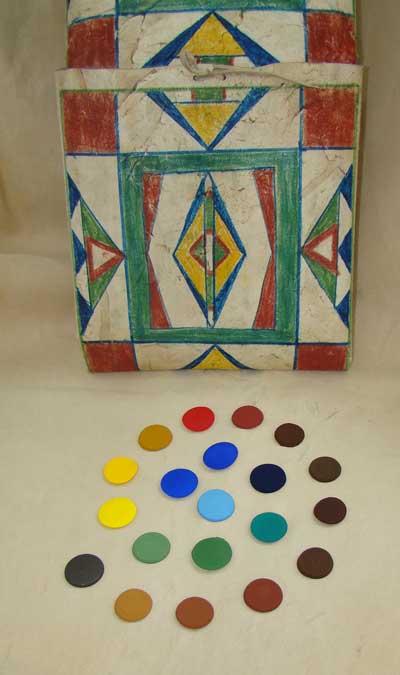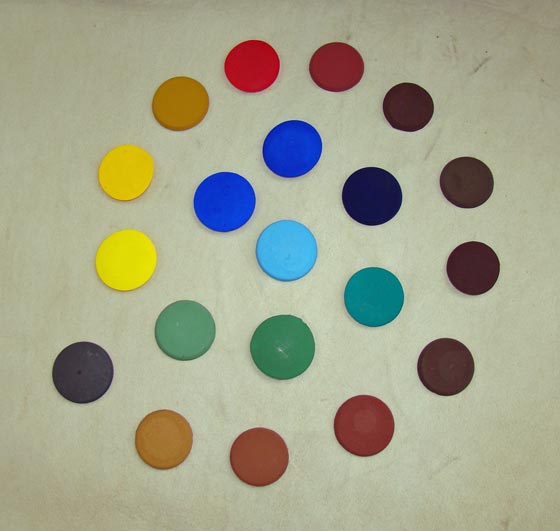
Parfleche painting cookies are now available for purchase
Here is a photo of the parfleche painting cookies illustrating the nice array of 20 different shades and colors. We have used the very best pigments that are perfect matches to what was available from 1840 through 1910 or so. Our cookies contain more premium pigments then are found in a 14 ml tube of the most expensive water colors paint tubes available today. One cookie will go a long way painting on wet/damp parfleche/rawhide. They are fun to use and are manipulated just as parfleche painting with cookis was done in the old days by hand. (We will send a how to print out with each cookie order).
It is of note that the cookie form for painting parfleche/rawhide has not been readily available either in this or most of the last century. So we are happy to be able to provide access to this wonderful nearly lost form of applying media.
Because these parfleche painting cookies are slightly concave and will hold enough water droplets, these cookies can also be used with either the bone brush of antiquity or regular artists paint brushes. Stiff brushes of various widths work great. We prefer using only the cookie for most of our work though. On some American Indian parfleches or parfleche bags, it is obvious that a free hand was used to paint them. On others, notably the transmontane style (Nez Perce, Wallawalla, Yakama, Shoshone, Crow and other Plains and Plateau tribes) at times used a straight edge when applying outlines on their parfleche pieces. Very early Crow Indian parfleches depict zoomorphic (animal) and anthropomorphic (human) designs. Usually these old Crow Indian parfelche cases are outlined in black or dark brown, with a back ground of an old red, with the animal or man design painted in the same deep brown/black that the outline had been painted with. On the Plateau and a few other places (Crow, Sioux parfleche) there also exists the rare and beautiful floral parfleche, which were undoubtedly done with a free hand and cookie! These cookies can be scored and broken into various size "brushes" for painting different width outlines or lines, and also for wider strokes in fill in areas. The cookie can be scored and broken into a half moon shape for fill in work and a long triangular shape for out lines. The third piece from this "scoring and breaking" effort will be a smaller half moon shape for filing to appropriate widths for fill in or other wider outline or line work. The possibilities are endless. There will be a diagram or photo of this to follow.

Parfleche Painting Cookies in Old Natural Mineral Pigments and Trade Pigment Colors
The cookies will be discussed starting with the light blue in the center of the spiral and then clockwise, working out to the end cookies in the spiral which is a dark grey/black. Each cookie blurb will also be keyed with the code used with each cookie in the next photo below.
Cookie B-1 Starting from the center of the spiral is a nice light blue found on Transmontane parfleche such as used by the Nez Perce, Shoshone, Crow, Bannock, Cayuse, Walla Walla, Klickitat, and other tribes from the Rocky Mountain Front, Plateau ans Great Basin areas. This light blue is also found elsewhere on the Great Plains. Most often used in small fill areas. I have seen it on rawhide bonnet cases more often than elsewhere.
B-2 The next marine blue is found throughout the Great Plains, Plateau, South West, and Southern Plains and other hide, rawhide and parfleche work. Used as major color fills, outlines and detail work on many pieces.
B-3 The next marine blue has more of a slight reddish tint to the blue, nearly not discernable but used as widely as the marine blue above in the same context.
B-4 The next blue is a dark blue found on many pieces throughout North America and goes back further into antiquity as a trade pigment then the blues noted above, again used as outlines and for detail work, as well as to paint large areas on parfleche, rawhide and hide pieces.
G-1 A nice light green the color known as pond scum green in the literature, used as a rare outline color on transmontane parfleche work, as well as fill in for larger areas.
G-2 A very common rich green seen on parfleche/rawhide from all areas.
G-3 Another trade green widely used on the Plains, Plateau and all other areas. This one tending toward blue but still green.
Y-1 A very beautiful and hard to find color in the original trade pigment. A bright and much sought after yellow in its day and even more so now. Used throughout the parfleche painting areas of North America.
Y-2 A beautiful darker yellow, seen on a lot of Nez Perce, Crow, Shoshone and other Plains both north and south and other Plateau and Rocky Mountain front tribes. Widely used back then, a scarce color today! A color found across the Plains and in all other areas, made with a scarce pigment.
Y-3 A natural earth yellow used throughout North America for parfleche/rawhide and brain tanned hide work.
R1 Back in the day a common red trade pigment, used all over North America, not so common today, and an expensive pigment.
R-2 A very nice earth red, used all over North America for parfleche/rawhide work and also hide painting and face/body painting. This red earth goes way back in antiquity. I have seen this color in a cache in Wisconsin that goes back before historic/proto-historic times.
R-3 Another earth red, a sort of brick red seen on a lot of parfleche, this one goes way back too.
E-1 This is the beginning of a series of brown/tan earth pigments that get lighter as we progress through them. This one E-1 is very dark and when seen on parfleche is mistaken with black from a distance. This one paints a nice deep brown.
E-2 A slightly lighter deep brown, seen on many parfleche.
E-3 A dark brown tending toward a reddish hue but not that discernable.
E-4 Close to number E-3 but a bit lighter and different in shade and tone, this one is seen used across the Plains and Plateau.
E-5 A nice medium brown tone found on parfleche from all areas especially the earlier plateau parfleche and flat cases. This tone and shade of brown is also seen on Cheyenne and other Plains Indian material.
E-6 A light brown tan, seen all over the Plains and Plateau.
E-7 A natural black that can be polished to a shine after application. The polished form is a rare black found on Blackfeet parfleche and flat cases. Care must be taken with this natural pigment because it will smear if not applied right and is the only one that will come off on your hands a bit without water. None the less it is a rare and useful cookie in that it can be used for doing exact replications of the rare parfleche that have the polished black on them. If applied when the hide is at optimum water content it is self sizing like the rest of our cookies.
R-4 This color is not in the spiral photo above nor the photo below. It is tagged in a photo below the keyed and priced photo below. Although orphaned in its own photograph that does not mean it is not a prominent color in the range of colors for parfleche painting. It is another very prominent trade red that was used throughout the parfleche making areas of North America. It is a few shades lighter then R-1. The reason it is not with the rest is that we were unable to locate the pigment until just a short time ago. So now you have it!